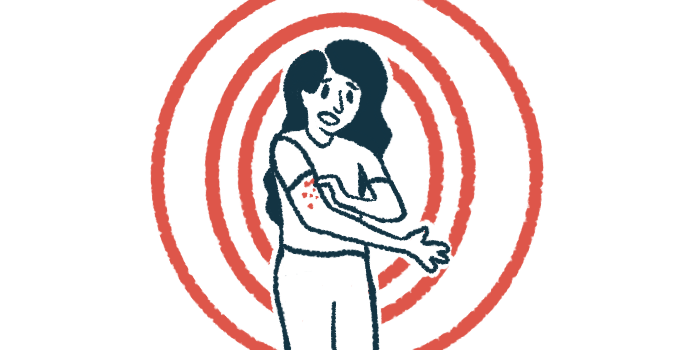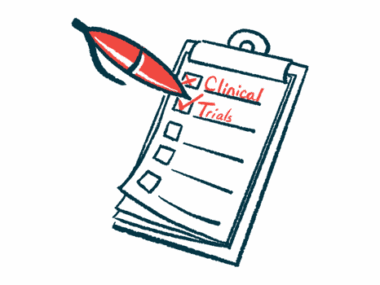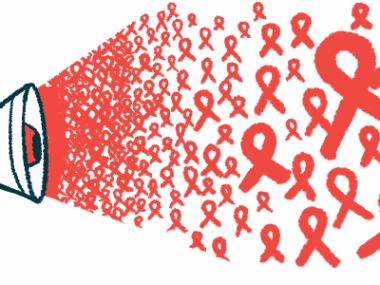JAK inhibitors seen to work better than dupilumab for EBP itching
Patients find relief with these anti-inflammatory meds in real-world study
Written by |

Treatment with Janus kinase (JAK) inhibitors — medications such as upadacitinib and baricitinib — was seen to work better than dupilumab at easing itching and skin lesions in people with epidermolysis bullosa pruriginosa (EBP) in a small real-world study.
Specifically, among five patients with known itch scores receiving dupilumab, two experienced a reduction of 50% in itching, and none showed complete itch relief. In contrast, all five patients with available itch scores treated with JAK inhibitors showed complete itching relief.
EBP is a form of dystrophic epidermolysis bullosa, which is characterized by intense itching, inflammation, and skin lesions.
Dupilumaban, an injection therapy approved for certain inflammatory disorders, has been used off-label to treat itch in some epidermolysis bullosa patients. JAK inhibitors, used in conditions like arthritis and ulcerative colitis, are another medication that works to reduce the inflammation that fuels such diseases.
“Our study suggests that JAK inhibitors may offer superior efficacy compared to dupilumab in treating EBP,” the researchers wrote.
The study was published as a research letter, titled “Real-world experience of using dupilumab and JAK inhibitors to manage pruritus in epidermolysis bullosa pruriginosa,” in Skin Health and Disease.
JAK inhibitors lead to complete itch relief for some patients
A major challenge in treating people with EBP, a condition caused by mutations in the COL7A1 gene, is to control itching. Certain anti-inflammatory medications, including dupilumab (approved under the brand name Dupixent for certain inflammatory conditions) and JAK inhibitors, may help relieve itching and reduce skin lesions in dystrophic epidermolysis bullosa patients.
Now, researchers in Taiwan reported their experience with both types of treatment for EBP. Three patients — ages 11, 28, and 43 — were treated with dupilumab, at a 300 mg dose given by subcutaneous, or under-the-skin, injection every two weeks, for a mean of 7.7 months.
The treatment moderately eased itching, with itch numeric rating scores (NRS) changing from a mean of seven before to 3.5 after treatment. On this scale, a score of zero indicates no itch and 10 represents the worst itching imaginable.
Three other patients, ages 18, 52, and 71, were treated with the JAK inhibitor abrocitinib. This medication was given orally, at doses of 100-200 mg, every day for a mean of five months. The therapy substantially eased itching, with the two patients with reported NRS scores experiencing complete relief.
Another two patients, ages 59 and 60, had a minimal response to dupilumab. One changed to abrocitinib, which completely eliminated itching after four months.
In our cohort, [JAK inhibitors] appeared to show better disease control of EBP.
The other patient improved with three months of dupilumab — with NRS scores dropping from 8.5 to 3.5 — but relapsed thereafter. A second round of dupilumab treatment led to minimal response. Changing to another drug, called upadacitinib, given orally at 15 mg/day for nine months, resulted in a major reduction in itching and skin lesions.
Finally, a 13-year-old boy had symptom relief after two months of dupilumab, but was lost to follow-up. One year later, he was experiencing itch recurrence and was treated for one month with abrocitinib, which was found to rapidly relieve his itching.
“In our cohort, [JAK inhibitors] appeared to show better disease control of EBP,” the researchers wrote.
Researchers assessed gene activity in some EBP patients
Regarding safety, no major adverse effects were reported. One patient treated with abrocitinib experienced mild dizziness, while another on upadacitinib experienced a slight increase in fat-like molecules.
The researchers then assessed changes in gene activity in patients treated with JAK inhibitors, by analyzing skin and blood samples. Skin samples were collected from two patients before and after upadacitinib or abrocitinib treatment, while blood samples were collected from two patients before and after use of upadacitinib.
In skin samples, treatment with JAK inhibitors suppressed gene activity in pathways involved in immune system activity and inflammation, namely the JAK-STAT, Th1/2 cell differentiation, and interleukin-17 pathways. No such effects were seen in blood samples.
“This may imply that the inflammation in EBP is [localized] to lesional skin instead of a systemic [body-wide] component,” the investigators wrote.
The team noted that the real-world nature of the study did not allow for direct treatment comparisons, which they noted as a limitation. Other limitations were the small number of patients, and a lack of patient matching.
Further, the researchers noted that “despite the clinical efficacy of [JAK inhibitors], the possible increased skin cancer risk should be cautioned in the treatment of EB patients.”







